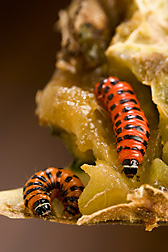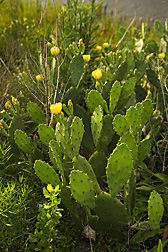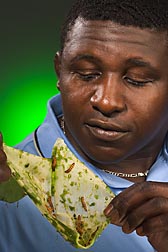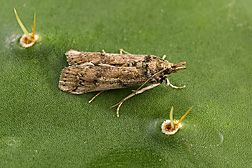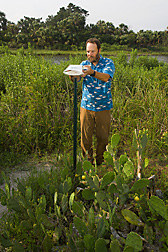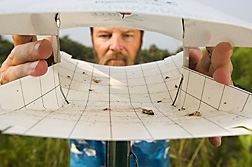Sticking It to the South American Cactus Moth
|
|
In the 1800s, prickly pear cacti were introduced into northeastern Australian prairies as living cattle fencing. It didn’t take long, however, for the cacti to become major weeds and cover about 16 million acres of land.
To control the advance of the prickly pear cactus, the Australians in 1925 began a classical biological control program. The first biological control agent they introduced was the South American cactus moth (Cactoblastis cactorum), which proved extremely effective in reducing the numbers of prickly pear cactus.
In 1957, the cactus moth was introduced to the island of Nevis in the West Indies, at the request of the host government. There, too, it successfully controlled pest cactus, but it didn’t stay put. It spread to the surrounding islands and later landed in the Florida Keys in 1989, threatening prickly pear cacti in the United States and in Mexico.
Since arriving in Florida, the cactus moth has rapidly moved along both the Atlantic and Gulf coasts. It is also found along barrier islands in South Carolina and Alabama. But it has not been found in the southwestern United States or Mexico—yet.
Tracking and Nullifying the Enemy Moth
Since 2003, USDA’s Agricultural Research Service (ARS) and Animal and Plant Health Inspection Service (APHIS) have teamed up with other stakeholders, like the Nature Conservancy, the U.S. Department of the Interior, the International Atomic Energy Agency, and Mexico, to develop a strategy to contain the cactus moth’s westward advancement.
ARS entomologist James Carpenter, in the Crop Protection and Management Research Unit in Tifton, Georgia, has been studying use of the sterile insect technique (SIT) to establish a barrier along the U.S. Gulf Coast. Before 2001, Carpenter, along with ARS’s Stephen Hight; APHIS’s Kenneth Bloem; and Stephanie Bloem, formerly from Florida A&M University, had been applying SIT to several moth species. In 2001, they began using it with the cactus moth. The moths are mass-reared on an artificial diet and irradiated to cause sterility.
“The irradiated cactus moths would be released in large numbers. Matings between irradiated and wild moths would result in fewer and sterile offspring,” says Carpenter.
The goal of SIT is to overwhelm the expanding population with sterile individuals, which drastically reduces the probability of wild females mating with fertile, wild males.
To induce sterility, a fairly high dosage of radiation is required—but that can leave the insects less competitive than unsterilized moths. Though this method does reduce populations, Carpenter has some interesting findings regarding the radiation levels. Lower radiation levels sterilize female insects but produce males with reduced fertility instead of sterility. Their offspring, however, are sterile, and insects treated with lower doses of radiation are more competitive.
“This may prove to be a more effective solution, since the moths with reduced fertility are not only more competitive in occupying the attention and efforts of the target population, but they also produce sterile offspring that further reduce the population of the following generation,” says Carpenter.
“The SIT trial is being conducted at the leading edge of the infestation on Dauphin Island, Alabama, to test the ability to create a barrier against the breeding moths,” says Carpenter. “Based on a field cage study, releasing only five times more sterile insects than fertile insects was enough to substantially lower the reproduction of fertile insects. Also, releasing both sterilized males and females was more effective than releasing only sterilized males.”
A pheromone for the cactus moth is in development by Robert Heath and others at ARS’s Subtropical Horticulture Research Station in Miami, Florida.
|
|
Pear-y Important
Though not a major U.S. crop, prickly pear cactus has significant value as an ecological plant, adding to wildlife habitat, ecosystem structure, and biodiversity. “It is important to prevent the moth from advancing to the Southwest, where the cactus is used as emergency forage for cattle during the winter months,” says Joel Floyd, who is with APHIS’s Pest Detection and Management Program. “The cactus is also part of the landscape nursery industry in the western United States and is in limited production in California.”
Prickly pear cacti are also important to Mexico’s desert ecosystems, with 53 species occurring there. The cactus is a major agricultural commodity in Mexico, with significant acreage devoted to crop and forage. It is grown as a vegetable, and the pads taste something like green beans. Different prickly pear cactus species produce flowers in an array of colors. The resulting fruit can be eaten raw or cooked into jams and preserves.
Floyd has devoted significant time to developing the strategic plan to beat back advancement of the cactus moth.
“It is very important to help prevent the moth’s advancement into Mexico, where the prickly pear cactus is an economically important crop,” he says. “The moth has certainly been worrisome since it was found in Florida. We now have an opportunity to do something about it.”
Use of previously vetted research allowed scientists to quickly and effectively respond to the invasion of the South American cactus moth.—By Sharon Durham, Agricultural Research Service Information Staff.
This work is part of Crop Protection and Quarantine, an ARS National Program (#304) described on the World Wide Web at www.nps.ars.usda.gov.
James Carpenter is at the USDA-ARS Crop Protection and Management Research Unit, 2747 Davis Road, Bldg. 1, Tifton, GA 31793-0748; phone (229) 387-2348, fax (229) 387-2321.
"Sticking It to the South American Cactus Moth" was published in the September 2006 issue of Agricultural Research magazine.







